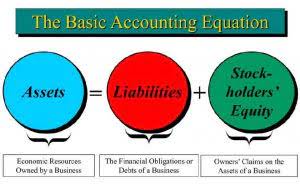Accounting Liabilities: Definition, Types, Examples, & Comparison

You can form an LLP in all 50 US states; however, some require specific state licensing for professional services. For example, California and New York require lawyers, architects, accountants, and other professionals to hold state licenses to form an LLP. California doesn’t allow licensed professionals to form LLCs, only LLPs.
- The current portion of the long-term refers to the part of long-term debt payable within one year.
- Generally, liability refers to the state of being responsible for something, and this term can refer to any money or service owed to another party.
- Assets are listed on the left side or top half of a balance sheet.
- The obligation to pay the vendor is referred to as accounts payable.
Investors and analysts will use a higher discount rate to value such a company, which would also lower the company’s value, and investors will demand higher returns. An increase in pension obligation will require employers to maintain higher/sufficient liquidity. Here, the Principal is the sum borrowed or the amount of money borrowed. Get up and running with free payroll setup, and enjoy free expert support. When you owe money to lenders or vendors and don’t pay them right away, they will likely charge you interest.
How to start an LLP
The third party to which the obligation must be paid (such as a supplier or lender) is known as the creditor. A federal tax lien is the government’s legal claim against a taxpayer’s property when they neglect or fail to pay a tax debt. The lien protects the government’s interest in all taxpayer’s property, including real estate, personal property and financial assets. Current liabilities have a greater immediate impact on a company’s liquidity and short-term solvency. They represent liabilities that must be settled as quickly as possible, as failing to do so may result in financial hardship.
It is an internal liability of the business and includes reserves and profits. A liability is an obligation payable by a business to either internal (e.g. owner) or an external party (e.g. lenders). There are mainly four types of liabilities in a business; current liabilities, non-current liabilities, contingent liabilities & capital. AT&T clearly defines its bank debt that is maturing in less than one year under current liabilities. For a company this size, this is often used as operating capital for day-to-day operations rather than funding larger items, which would be better suited using long-term debt. Accrued Expenses – Since accounting periods rarely fall directly after an expense period, companies often incur expenses but don’t pay them until the next period.
Impact of Liabilities on Financial Variables
On the other hand, Non-current liabilities, even if they are not due immediately, can have an impact on a company’s long-term financial stability and creditworthiness. The maturity term is a key difference between current and non-current liabilities. Current liabilities are normally due within one year of the operating cycle, but non-current liabilities have longer repayment dates, usually exceeding one year. For instance, liabilities in accounting in 2016, Johnson & Johnson reported $5.4 billion in other long-term liabilities, including legal settlements and environmental liabilities. This article offers a comprehensive guide to understanding liabilities, their types, recognition, recording, financial statement analysis, and management strategies. Real-world examples are provided to enhance understanding and demonstrate the practical application of these concepts.
- For example, California and New York require lawyers, architects, accountants, and other professionals to hold state licenses to form an LLP.
- Typical examples of current liabilities are your credit card bills, staff salaries, accounts payable, and overdraft fees on your bank account.
- Non-current liabilities are due in more than one year and most often include debt repayments and deferred payments.
- Accrued expenses are recorded but not yet paid and therefore represent a liability for the company.
- In short, there is a diversity of treatment for the debit side of liability accounting.
In 2020, Boeing Co. reported $15.3 billion in pension liabilities. In 2015, Verizon Communications had a current portion of long-term debt of $9.5 billion. Another popular calculation that potential investors or lenders might perform while figuring out the health of your business is the debt to capital ratio. The important thing here is that if your numbers are all up to date, all of your liabilities should be listed neatly under your balance sheet’s “liabilities” section.
Type 4: Taxes payable
They are any expenses that your business needs to pay within 12 months and, in reality, usually within a few months. These are the typical expenses that your business incurs in order to operate day-to-day. Fixed assets are also called long-term assets because they are owned for a longer period of time. In terms of your balance sheet, any asset owned, or expected to be owned, for longer than 12 months is a fixed asset. Accrued expenses are yet to be paid and therefore represent a liability.

Current assets represent all the assets of a company that are expected to be conveniently sold, consumed, used, or exhausted through standard business operations within one year. Current assets appear on a company’s balance sheet and include cash, cash equivalents, accounts receivable, stock inventory, marketable securities, prepaid liabilities, and other liquid assets. Current liabilities are typically settled using current assets, which are assets that are used up within one year.
Liabilities vs. Expenses
When the supplier delivers the inventory, the company usually has 30 days to pay for it. This obligation to pay is referred to as payments on account or accounts payable. Each of the accounts in the chart of accounts corresponds to the two main financial statements, i.e., the balance sheet and income statement. When setting up a chart of accounts, typically, the accounts that are listed will depend on the nature of the business. For example, a taxi business will include certain accounts that are specific to the taxi business, in addition to the general accounts that are common to all businesses. The chart of accounts is a tool that lists all the financial accounts included in the financial statements of a company.
The accounting equation is the mathematical structure of the balance sheet. In totality, total liabilities are always equal to the total assets. A liability may be part of a past https://www.bookstime.com/ transaction done by the firm, e.g. purchase of a fixed asset or current asset. The settlement of liability is expected to result in an outflow of funds from the business.
